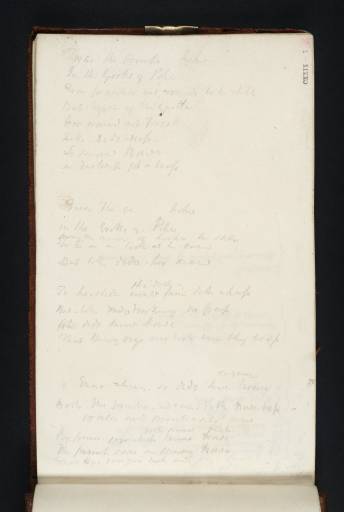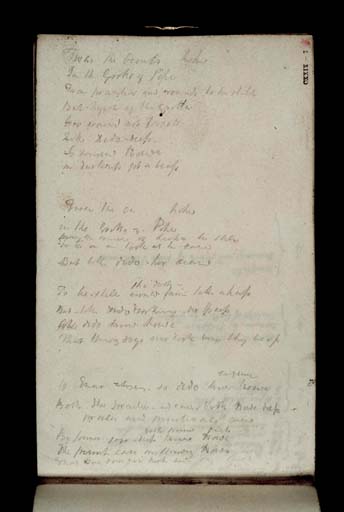Joseph Mallord William Turner Stanzas Referring to Jonathan Wathen Phipps and Baroness Howe (Inscription by Turner) c.1812-13
Image 1 of 2
Joseph Mallord William Turner,
Stanzas Referring to Jonathan Wathen Phipps and Baroness Howe (Inscription by Turner)
c.1812-13
Joseph Mallord William Turner 1775–1851
Folio 7 Recto:
Stanzas Referring to Jonathan Wathen Phipps and Baroness Howe (Inscription by Turner) c.1812–13
D09067
Turner Bequest CXXIX 7
Turner Bequest CXXIX 7
Pencil on white wove paper, 110 x 178 mm
Inscribed by Turner in pencil with verses (see main catalogue entry)
Trace of inscription by ?John Ruskin in red ink ‘7 [?]’ bottom right
Stamped in brown ‘CXXIX 7’ bottom right
Inscribed by Turner in pencil with verses (see main catalogue entry)
Trace of inscription by ?John Ruskin in red ink ‘7 [?]’ bottom right
Stamped in brown ‘CXXIX 7’ bottom right
Accepted by the nation as part of the Turner Bequest 1856
References
1909
A.J. Finberg, A Complete Inventory of the Drawings of the Turner Bequest, London 1909, vol.I, p. 361, CXXIX 7, as ‘Verses about Dido and Eneas’.
1966
Jack Lindsay, J.M.W. Turner: His Life and Work: A Critical Biography, London 1966, pp.126, 237 note 6.
1985
Jack Lindsay, Turner: The Man and His Art, London 1985, p.100.
1990
Kathleen Nicholson, Turner’s Classical Landscapes: Myth and Meaning, Princeton 1990, p.294, note 22.
1990
Andrew Wilton and Rosalind Mallord Turner, Painting and Poetry: Turner’s ‘Verse Book’ and his Work of 1804–1812, exhibition catalogue, Tate Gallery, London 1990, p.176.
1990
Gerald Finley, ‘Love and Duty: J.M.W. Turner and the Aeneas Legend’, Zeitschrift für Kunstgeschichte, vol.55, 1990, pp.376–90, p. 380 note 25.
1999
Gerald Finley, Angel in the Sun: Turner’s Vision of History, Montreal and Kingston [Canada] 1999, pp.65, 221 note 57.
Written from right to left down the page, as if working from the inside the back cover and continued on folio 6 recto (D09066), opposite, Turner’s inscription reads:
Twas the Oculist’s hope
In the Grotto of Pope
From practice and wounds to be still
But Nymph of the Grotto
From wound not ...
Like Dido deep [?]
So knew Howe
In darkness got a leap [?]
In the Grotto of Pope
From practice and wounds to be still
But Nymph of the Grotto
From wound not ...
Like Dido deep [?]
So knew Howe
In darkness got a leap [?]
Twas the Oc[ulist’s] hope
In the Grotto of Pope
From [the muse?] of [darker to?] still
To lie on and look at her case
But ... Dido her [ease?]
In the Grotto of Pope
From [the muse?] of [darker to?] still
To lie on and look at her case
But ... Dido her [ease?]
To be still would ^tho doth fain look [asleep?]
But like Dido dark[en]ing did sleep
Like Dido knew Howe
That springing dogs ner look before they leap
But like Dido dark[en]ing did sleep
Like Dido knew Howe
That springing dogs ner look before they leap
So Eneas returns so Dido knew [require ] Howe
Both the practice and ease both made deep
practice and practice ease
both knew deep
By former joys deep knows Howe
The present case in knowing Howe
That Howe does ner look before she leaps’1
Both the practice and ease both made deep
practice and practice ease
both knew deep
By former joys deep knows Howe
The present case in knowing Howe
That Howe does ner look before she leaps’1
Turner continues to dwell on the liaison of Baroness Howe of Pope’s Villa, Twickenham and Jonathan Wathen Phipps, oculist to George III, who were married in October 1812; see notes to inside front cover of the sketchbook (D40818). Here Turner attempts to develop an equation between the protagonists and Dido and Aeneas whose romance had been a favourite theme around 1804–5, but it is hard to make much sense of the comparison. He continues this line of thought on folio 6 verso, opposite (D09066) and it looks very much as if he is trying to compose bons mots with which to entertain a party, perhaps after dinner at Farnley Hall, the seat of his Yorkshire friend and patron Walter Fawkes. The result would certainly have been comical, if not quite in the way Turner hoped.
Verso:
Blank
David Hill
October 2008
How to cite
David Hill, ‘Stanzas Referring to Jonathan Wathen Phipps and Baroness Howe (Inscription by Turner) c.1812–13 by Joseph Mallord William Turner’, catalogue entry, October 2008, in David Blayney Brown (ed.), J.M.W. Turner: Sketchbooks, Drawings and Watercolours, Tate Research Publication, September 2014, https://www


